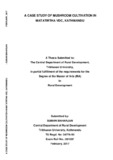Please use this identifier to cite or link to this item:
https://elibrary.tucl.edu.np/handle/123456789/2314| Title: | A Case Study of Mushroom Cultivation in Matatirtha Vdc, Kathmandu |
| Authors: | Maharjan, Suman |
| Keywords: | Cultivation;Mushroom Culture |
| Issue Date: | Feb-2017 |
| Publisher: | Central Department of Rural Development Tribhuvan University, Kathmandu |
| Abstract: | Nepal is one of the countries where mushroom can be cultivated throughout the year under natural environmental condition. We can use most of agriculture wastage. We have plenty of raw materials for mushroom cultivation. Skilled farmers can earn a lot of money from its cultivation. Oyster mushroom is very popular in Nepal where it can be grown all round the year. Mushroom farming is highly growing in Nepal as there are lots of places across the country, among them Kathmandu district is one where mushroom cultivation has higher potentiality. Kathmandu, a district that falls under the Central development region, lies in the Bagmati Zone of Nepal and it has suitable climate for production as well as market for the farmed product. This District has lots of areas that are suitable for farming but among them Matatirtha VDC is one of them, which around is 1 hour away from centre of Kathmandu. The general objective of the study was to find out prospects and challenges of mushroom cultivation in Matatitha VDC of Kathmandu District. Whereas specific objectives of the study were to find out the technique, cost and benefit of mushroom cultivation of the study area and to analyze the problem and prospect of mushroom cultivation in the study area. This study has been carried out mostly on the basis of exploratory research design; also descriptive method of research design is used in order to describe the findings during the study. Qualitative and quantitative data have been collected for the study using both primary and secondary sources. Of the total households, 50 households have been taken as sample for the study area by applying quto sampling technique.. To collect data, household survey, key informant interview, observation, method have been used and different computer program, simple statistical tools like table, graphs, have been used for data analysis and descriptive methods has been used for qualitative data. After the research different findings were obtain. It was found that among respondents 68% were male and 32% were found female, 5 respondents were found age below 30 and 34 respondents were found age between (30 to 50), 11 respondents were found age above 50. 6 respondents were illiterate, 30 were literate and remaining 14 7 respondents had education level above SLC. It was found that Newar and Magar community dominates the study area. Among 50 respondents 38 respondents were engaged in farming, 3 were in teaching sector, 5 respondents were involved in private job or self employment and 4 respondents was in social service. After the study it can be concluded that mainly used farming technique in the study area In terms of techniques of growing mushroom it was found that 80% of respondents use hanger technique to cultivate mushroom whereas tray and floor were not so popular. It was found that farmers have been following the planting method for the cultivation of mushroom rather than spraying method. It was found out that 92% respondent use hay and 8% respondent use mud as medium for mushroom farming. Mostly relying on traditional method of farming. Study was made in order to find cost and benefit of mushroom farming in study area and after the completion of study we can conclude that it takes minimum 3 weeks for the mushroom production and per bag average production is 2 kg. At least 5 manpower are needed per day for the mushroom production. It was found out that mushroom on the field were sold at Rs. 95 where as in market after adding travelling cost it can be sold at Rs. 110 per kg. So there breakeven point is Rs. 110 but most of the farmers seem not so happy with the price they get in market. Study was to analyze the problems and prospects of mushroom cultivation in study area so after the completion of study it can be concluded that most of the farmers are untrained and have been farming without using any modern means and techniques mainly due to lack of instruments. Training on mushroom farming should be provided so that there won‟t be any shortage of manpower for mushroom farming. Different new modern equipments, tools and techniques with trained manpower should be provided for better result. The modern machines should be introduced in reasonable price so that farmers can enhance their production |
| URI: | http://elibrary.tucl.edu.np/handle/123456789/2314 |
| Appears in Collections: | Rural Development |
Items in DSpace are protected by copyright, with all rights reserved, unless otherwise indicated.

